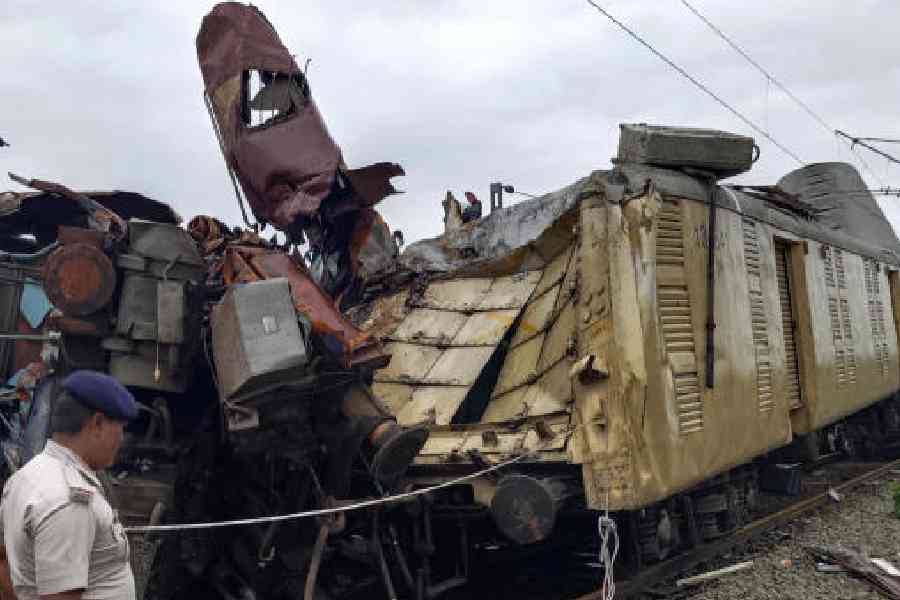Missing Kavach in train tragedy: Anti-collision device nowhere to be seen on tracks
Kavach, the system to help prevent collisions if two trains are on the same tracks, is not installed on the tracks where Monday’s accident occurred
 |
| The mangled train at Chhoto Nirmaljote near Rangapani railway station, Siliguri subdivision, on Monday: Picture by Passang Yolmo |
Sanjay Mandal, Debraj Mitra, TT Delhi Bureau, Calcutta, 18.06.24 : An anti-collision device to help avert train accidents like the one at Chhoto Nirmaljote where a goods train rammed into the Sealdah-bound Kanchenjunga Express, would take years to be installed across India’s railway network because of high cost and technical challenges, railway officials said on Monday.
Kavach, the system to help prevent collisions if two trains are on the same tracks, is not installed on the tracks where Monday’s accident occurred.
This revelation by Railway Board chairperson Jaya Varma Sinha underscores the ongoing challenge of equipping India’s vast rail network with this crucial shield. “It is not there right now,” she said, adding Kavach was being planned for the route.
Senior railway officials said Kavach, for which field trial was started in 2016, has been installed only in less than 1,500km of tracks out of the total 70,000km covered by the Indian Railways across the country.
Pointing towards a possible “human error” on the part of the loco pilot of the goods train who died in the accident, Sinha said the collision near New Jalpaiguri may have happened because the goods train disregarded the signal and hit the Kanchenjunga Express.
Chief minister Mamata Banerjee, who visited the accident site, blamed the Centre for the slow pace of work.
“One accident after another is happening. Many bodies are still lying unidentified. Accidents can happen. But at the same time, it is also a fact that I prepared the anti-collision device system during my tenure as railway minister. I used Konkan Railway (for a pilot project) in Mumbai and Goa. I personally visited Madgaon for the project,” Mamata said. “The system is built in such a way that it will work even if the driver falls asleep. It will raise the alarm. If two trains come close to one another, the system will stop them.”
Mamata added: “They (the Narendra Modi government) might give a new name to everything. But first become a shield for people, then talk big. Now, the focus on publicity is much more than the actual work being done.” She added that the railways "have become an orphan”.
India’s Kavach journey began in 2012, with testing between 2016 and 2019.
Kavach, an automatic train protection (ATP) system, was developed by the Research Design and Standards Organisation (RSCO) with three Indian firms, said railway sources.
Senior railway officials said Kavach, for which field trial was started in 2016, has been installed only in less than 1,500km of tracks out of the total 70,000km covered by the Indian Railways across the country.
“Kavach was installed in the South Central Railway division as a pilot project nearly three years back. The project, after going through several trials, is now successful and will be installed in other divisions too,” said a senior railway official.
“High costs and technical difficulties have slowed down the progress of installation,” he, however, admitted.
Kavach offers significant safety benefits. The system can automatically alert drivers, apply brakes, and even halt trains to prevent collisions from signal passed at danger (SPAD) and overspeeding. It also assists in navigating adverse weather conditions and low visibility, enhancing operational safety.
But the Kavach rollout faces several hurdles. First, the cost is substantial. Equipping tracks and stations costs some ₹50 lakh per kilometer, while locomotives require an additional ₹70 lakh each. Secondly, ramping up production by suppliers is crucial to expedite wider implementation. So far, the railways depended on indigenous suppliers. Reportedly, discussions are on to involve overseas players like Japan’s Kyosan Electric, as well as European majors Siemens and Alstom to step up supply.
Two years ago in her February budget speech, finance minister Nirmala Sitharaman had promised that 2,000km would be brought under Kavach. The target has not yet been reached in 2024.
According to a disclosure in Parliament in December 2023, tenders have been awarded for Delhi–Mumbai and Delhi-Howrah corridors (some 3,000km).
In February, Eastern Railway had said the Kavach trials were underway on
the 260km Howrah–Chhota Ambana (Jharkhand) section of the Delhi-Howrah corridor. Starting from March 15, 2023, the Kavach system has
been installed in 46 locomotives of Eastern Railway, a communication on February 26 said.
Railway Board chairperson Sinha said on Monday there was a plan to install Kavach in the Delhi-Guwahati route. On Bengal, Sinha said: “The 3,000km we are planning this year includes the Delhi-Howrah route.”
Additional reporting by our Delhi bureau
Posting Komentar untuk " Missing Kavach in train tragedy: Anti-collision device nowhere to be seen on tracks"